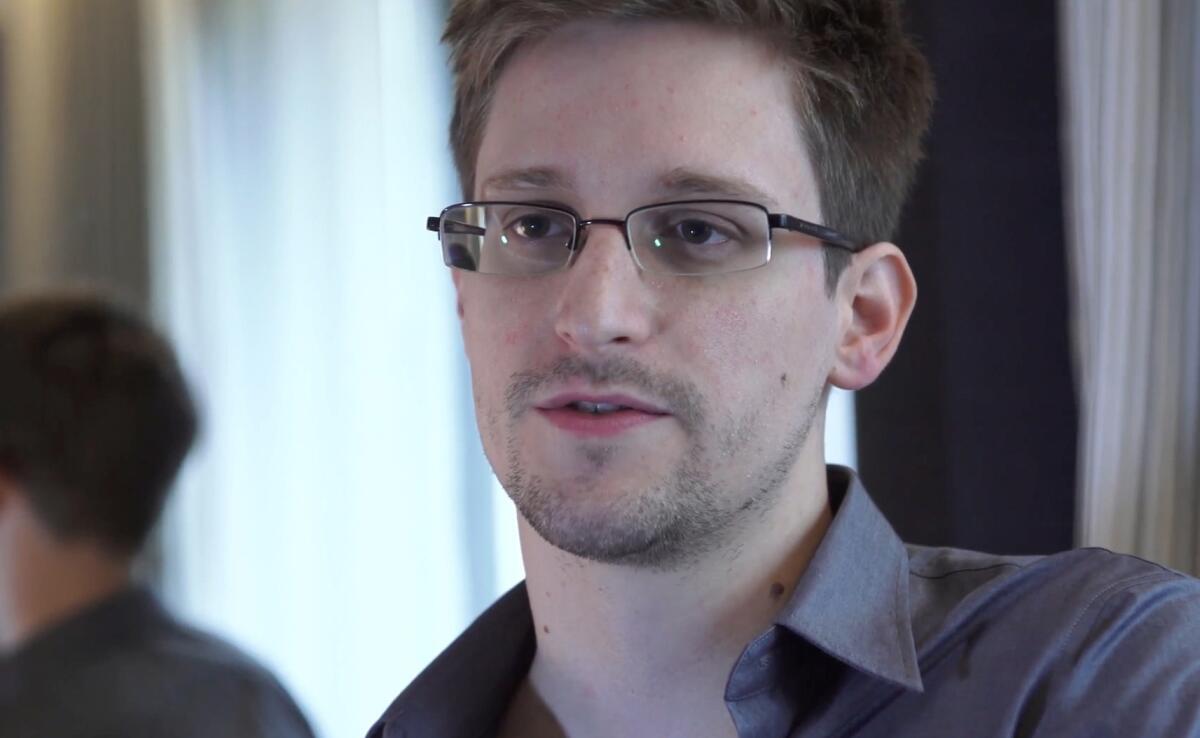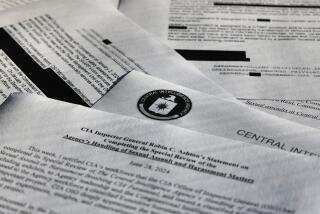Op-Ed: Glenn Greenwald: Why the CIA is smearing Edward Snowden after the Paris attacks

Edward Snowden in Hong Kong in July 2013. Glenn Greenwald, a journalist to whom Snowden made his disclosures, writes that the CIA is smearing Snowden and Silicon Valley in the wake of the terrorist attacks.
Decent people see tragedy and barbarism when viewing a terrorism attack. American politicians and intelligence officials see something else: opportunity.
Bodies were still lying in the streets of Paris when CIA operatives began exploiting the resulting fear and anger to advance long-standing political agendas. They and their congressional allies instantly attempted to heap blame for the atrocity not on Islamic State but on several preexisting adversaries: Internet encryption, Silicon Valley’s privacy policies and Edward Snowden.
The real objective is to depict Silicon Valley as terrorist-helpers for the crime of offering privacy protections to Internet users.
The CIA’s former acting director, Michael Morell, blamed the Paris attack on Internet companies “building encryption without keys,” which, he said, was caused by the debate over surveillance prompted by Snowden’s disclosures. Sen. Dianne Feinstein (D-Calif.) blamed Silicon Valley’s privacy safeguards, claiming: “I have asked for help. And I haven’t gotten any help.”
Former CIA chief James Woolsey said Snowden “has blood on his hands” because, he asserted, the Paris attackers learned from his disclosures how to hide their communications behind encryption. Woolsey thus decreed on CNN that the NSA whistleblower should be “hanged by the neck until he’s dead, rather than merely electrocuted.”
In one sense, this blame-shifting tactic is understandable. After all, the CIA, the NSA and similar agencies receive billions of dollars annually from Congress and have been vested by their Senate overseers with virtually unlimited spying power. They have one paramount mission: find and stop people who are plotting terrorist attacks. When they fail, of course they are desperate to blame others.
The CIA’s blame-shifting game, aside from being self-serving, was deceitful in the extreme. To begin with, there still is no evidence that the perpetrators in Paris used the Internet to plot their attacks, let alone used encryption technology.
CIA officials simply made that up. It is at least equally likely that the attackers formulated their plans in face-to-face meetings. The central premise of the CIA’s campaign — encryption enabled the attackers to evade our detection — is baseless.
Even if they had used encryption, what would that prove? Are we ready to endorse the precept that no human communication can ever take place without the U.S. government being able to monitor it? To prevent the CIA and FBI from “going dark” on terrorism plots that are planned in person, should we put Orwellian surveillance monitors in every room of every home that can be activated whenever someone is suspected of plotting?
The claim that the Paris attackers learned to use encryption from Snowden is even more misleading. For many years before anyone heard of Snowden, the U.S. government repeatedly warned that terrorists were using highly advanced means of evading American surveillance.
Then-FBI Director Louis Freeh told a Senate panel in March 2000 that “uncrackable encryption is allowing terrorists — Hamas, Hezbollah, Al Qaeda and others — to communicate about their criminal intentions without fear of outside intrusion.”
Or consider a USA Today article dated Feb. 5, 2001, eight months before the 9/11 attack. The headline warned “Terror groups hide behind Web encryption.” That 14-year-old article cited “officials” who claimed that “encryption has become the everyday tool of Muslim extremists.”
Even the official version of how the CIA found Osama bin Laden features the claim that the Al Qaeda leader only used personal couriers to communicate, never the Internet or telephone.
Within the Snowden archive itself, one finds a 2003 document that a British spy agency called “the Jihadist Handbook.” That 12-year-old document, widely published on the Internet, contains instructions for how terrorist operatives should evade U.S. electronic surveillance.
In sum, Snowden did not tell the terrorists anything they did not already know. The terrorists have known for years that the U.S. government is trying to monitor their communications.
What the Snowden disclosures actually revealed to the world was that the U.S. government is monitoring the Internet communications and activities of everyone else: hundreds of millions of innocent people under the largest program of suspicionless mass surveillance ever created, a program that multiple federal judges have ruled is illegal and unconstitutional.
That is why intelligence officials are so eager to demonize Snowden: rage that he exposed their secret, unconstitutional schemes.
But their ultimate goal is not to smear Snowden. That’s just a side benefit. The real objective is to depict Silicon Valley as terrorist-helpers for the crime of offering privacy protections to Internet users, in order to force those companies to give the U.S. government “backdoor” access into everyone’s communications. American intelligence agencies have been demanding “backdoor” access to encryption since the mid-1990s. They view exploitation of the outrage and fear resulting from the Paris attacks as their best opportunity yet to achieve this access.
The key lesson of the post-9/11 abuses — from Guantanamo to torture to the invasion of Iraq — is that we must not allow military and intelligence officials to exploit the fear of terrorism to manipulate public opinion. Rather than blindly believe their assertions, we must test those claims for accuracy. In the wake of the Paris attacks, that lesson is more urgent than ever.
Glenn Greenwald is a founding editor of the Intercept. He led the reporting for the Guardian’s 2013 series on global surveillance programs, based on classified documents disclosed by Edward Snowden, which was awarded the Pulitzer Prize for Public Service.
Follow the Opinion section on Twitter @latimesopinion and Facebook
MORE OPINION NEWS
Eat, shop, click: Another kind of Black Friday
Mexican migrants are heading back home — and that’s bad news for the U.S. economy
More to Read
A cure for the common opinion
Get thought-provoking perspectives with our weekly newsletter.
You may occasionally receive promotional content from the Los Angeles Times.










